
Edirne, historically known as Adrianople, is a city in Turkey, in the northwestern part of the province of Edirne in Eastern Thrace. Situated 7 km (4.3 mi) from the Greek and 20 km (12 mi) from the Bulgarian borders, Edirne was the second capital city of the Ottoman Empire from 1369 to 1453, before Constantinople became its capital.
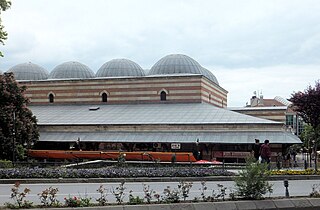
A bedesten is a type of covered market or market hall which was historically found in the cities of the Ottoman Empire. It was typically the central building of the commercial district of an Ottoman town or city, where the most important and precious goods were kept and sold. Its function was comparable or equivalent to that of a qaysariyya in other regions, though the architecture of the latter could be different and be similar to that of a bazaar with its own streets.

The Bayezid II Mosque is an early 16th-century Ottoman imperial mosque located in Beyazıt Square in Istanbul, Turkey, near the ruins of the Forum of Theodosius of ancient Constantinople.
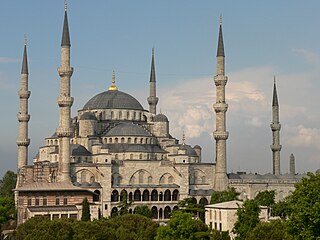
Ottoman architecture is an architectural style or tradition that developed under the Ottoman Empire over a long period, undergoing some significant changes during its history. It first emerged in northwestern Anatolia in the late 13th century and developed from earlier Seljuk Turkish architecture, with influences from Byzantine and Iranian architecture along with other architectural traditions in the Middle East. Early Ottoman architecture experimented with multiple building types over the course of the 13th to 15th centuries, progressively evolving into the classical Ottoman style of the 16th and 17th centuries. This style was a mixture of native Turkish tradition and influences from the Hagia Sophia, resulting in monumental mosque buildings focused around a high central dome with a varying number of semi-domes. The most important architect of the classical period is Mimar Sinan, whose major works include the Şehzade Mosque, Süleymaniye Mosque, and Selimiye Mosque. The second half of the 16th century also saw the apogee of certain Ottoman decorative arts, most notably in the use of Iznik tiles.

The large Fatih Mosque is an Ottoman mosque off Fevzi Paşa Caddesi in the Fatih district of Istanbul, Turkey. The original mosque was constructed between 1463 and 1470 on the site of the Church of the Holy Apostles. Seriously damaged in the 1766 earthquake, it was rebuilt in 1771 to a different design. It is named after the Ottoman sultan Mehmed the Conqueror, known in Turkish as Fatih Sultan Mehmed, who conquered Constantinople in 1453.

The Laleli Mosque is an 18th-century Ottoman imperial mosque located in Laleli, Fatih, Istanbul, Turkey.

The Nuruosmaniye Mosque is an 18th-century Ottoman mosque located in the Çemberlitaş neighbourhood of Fatih district in Istanbul, Turkey, which was inscribed in the Tentative list of World Heritage Sites in Turkey in 2016.
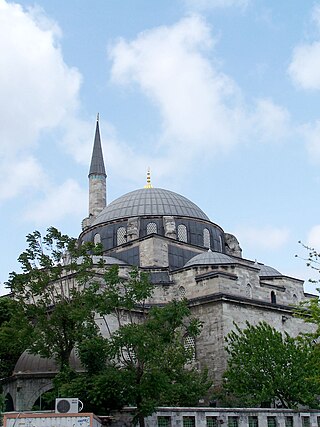
The Gazi Atik Ali Pasha Mosque is a 15th-century Ottoman mosque located in the Çemberlitaş neighbourhood of the Fatih district in Istanbul, Turkey. Its construction was started under the orders of the future Grand Vizier Hadım Atik Ali Pasha in 1496 and was completed in 1497, during the reign of Sultan Bayezid II. The mosque is located near the entrance to the Kapalıçarşı, the Column of Constantine, and the historical Nuruosmaniye Mosque.
Köse Mihal accompanied Osman I in his ascent to power as a bey and founder of the Ottoman Empire. He is considered to be the first significant Byzantine renegade and convert to Islam to enter Ottoman service.

Yalnızgöz Bridge is a historic Ottoman bridge in Edirne, Turkey. It crosses the Tunca.

Meriç Bridge, a.k.a.Yeni Köprü, meaning New Bridge or Mecidiye Bridge, after Sultan Abdülmecid I, is a historic Ottoman bridge in Edirne, Turkey. It crosses the Meriç river, formerly carrying the state road D.100, connecting Pazarkule border gate through Karaağaç to Edirne. It has since been bypassed by Dr. Mehmet Müezzinoğlu Bridge.
Yeni Imaret Bridge is a historic Ottoman bridge in Edirne, Turkey. It crosses the Tunca.

Fatih Bridge, a.k.a. Bönce Bridge, is a historic Ottoman bridge in Edirne, Turkey. It crosses the Tunca, connecting Edirne Palace to the city.
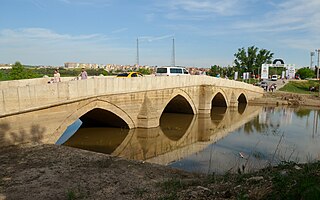
Kanuni Bridge or Palace Bridge, is a historic Ottoman bridge in Edirne, Turkey. It crosses the Tunca river, connecting Edirne Palace with the city. It is named after Suleiman the Magnificent, known in Turkish by the epithet "the Lawmaker", who commissioned the construction.

Nilüfer Hatun Imareti, a convent annex hospice for dervishes, now housing the Iznik Museum in İznik, Bursa Province, Turkey. This elegant building was erected in 1388 for Murad I who dedicated it to his later mother Nilüfer Hatun.

Halime Hatun was, according to Ottoman folklore, the wife of Ertuğrul and the mother of Osman I.
The Bridges of Edirne are a series of bridges from the Ottoman period at Edirne in Turkey, approximately 240 km to the west of Istanbul.
Beçin was a historical fort in Turkey.

Classical Ottoman architecture is a period in Ottoman architecture generally including the 16th and 17th centuries. The period is most strongly associated with the works of Mimar Sinan, who was Chief Court Architect under three sultans between 1538 and 1588. The start of the period also coincided with the long reign of Suleiman the Magnificent, which is recognized as the apogee of Ottoman political and cultural development, with extensive patronage in art and architecture by the sultan, his family, and his high-ranking officials.
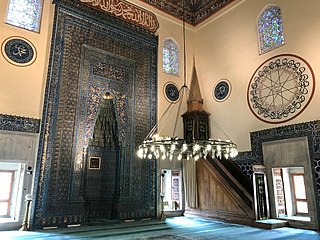
Early Ottoman architecture corresponds to the period of Ottoman architecture roughly up to the 15th century. This article covers the history of Ottoman architecture up to the end of Bayezid II's reign, prior to the advent of what is generally considered "classical" Ottoman architecture in the 16th century. Early Ottoman architecture was a continuation of earlier Seljuk and Beylik architecture while also incorporating local Byzantine influences. The new styles took shape in the capital cities of Bursa and Edirne as well as in other important early Ottoman cities such as Iznik. Three main types of structures predominated in this early period: single-domed mosques, "T-plan" buildings, and multi-domed buildings. Religious buildings were often part of larger charitable complexes (külliyes) that included other structures such as madrasas, hammams, tombs, and commercial establishments.
















